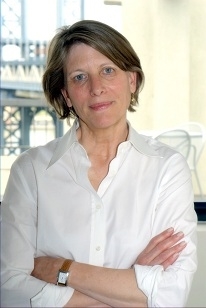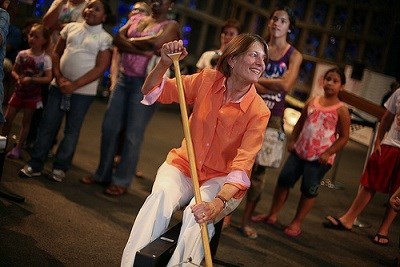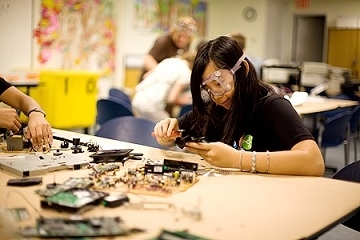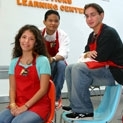 |
| Dr. Margaret Honey (NYSCI ()) |
Innovative. Visionary. Groundbreaking. These are just a few of the words that describe Dr. Margaret Honey's quest to transform the way we educate our children in science, math, engineering and technology. Dr. Honey graduated from Columbia University with a doctorate in developmental psychology and a bachelor's from Hampshire. She is well known for supporting children's learning in these areas with the use of cutting edge digital technologies. She has directed numerous projects exploring new ways of learning while collaborating with some of the nation's largest public broadcasters, including PBS and CPB. Under the umbrella of Bank Street College of Education, Dr. Honey has helped to create one of the first internet-based professional development programs in the country. Dr. Honey is currently President and CEO of the New York Hall of Science, one of the few remaining structures of the 1964 New York World's Fair in Queens, outside of New York City. NYSCI features more than 450 hands on exhibits in the worlds of science and technology, suitable for all ages.
But how did Margaret Honey end up where she is today? And what role have her own teachers played in shaping her path? Dr. Honey told My Hero that the educators who were most influential in her own development were several she encountered after school. "They gave me the gift of enacting what is possible - they showed me that we can create rich, stimulating and caring classroom environments that help all children learn deeply and well."
 |
| Dr. Honey on Dragon Boat at NYSCI (NYSCI ()) |
The first of these influential mentors she met in 1985 when she was a young researcher working at Bank Street College of Education on a mixed media show called The Voyage of the Mimi. Bruce Kanz, was a grade 5/6 teacher at Debbie Meier's Central Park East School in East Harlem. Dr. Honey told My Hero, "Bruce had built his entire curriculum around the study of the ancient Maya - the same theme that our television series was built around. Bruce's classroom was a wonderful learning environment, Bruce was a masterful teacher, and the kids were deeply engaged in their Maya projects - making hieroglyphic quilts with seniors in the local center, building Maya temples, and helping us create the games that would eventually become the backdrop for a software program we developed called Maya Math.
What I admired most deeply about Bruce, and what I think made him such a stand out educator was a singular combination of patience coupled with a deeply diagnostic passion for who his students were. He knew each of them well; he saw their strengths and helped them to work through their weaknesses. He knew about their families - and by this I mean who knew much more than the cliched and rather tired phrase we have adopted of "parental involvement." Bruce knew what Dad's were up to, who had gotten a new job, whose mom was finishing a college degree. He saw commitment and strength in the students' families, not deficit or deficiency. He used all of this - everything he could glean and understand - to know his kids well. Bruce's classroom was rich and lively and yet it never spun out of control. It always felt safe, and contained - like a really nurturing home. I associate this with Bruce's patience. Every question was answered, and every student was the recipient of thoughtful, considered interactions with Bruce. And, he never hesitated to ask for help. The day I walked into Bruce's classroom, he said, "You must be the lady from Bank Street. I'm sure you know more about Maya math than I do; would you be willing to help that group of kids?" He pointed across the room, and I joined a trio of boys, and as I like to say, I never left."
She was also greatly influenced by her mentor Fred Carrigg, Executive Director of Academic Programs, who she met in 1992 when her work brought her to the schools of Union City, New Jersey. Well before the days of the world wide web and instant access to the internet "Bell Atlantic wanted to experiment with bringing new technologies to education and had contracted Bank Street's Center for Children and Technology to help with the design, implementation, and documentation of the work. The story of Union City and what I learned has much less to do with technology than with importance of vision, leadership, and dogged commitment when using education as the vehicle to improve the lives of children who came from largely first generation immigrant families. When we arrived in the district, they were in their second year of a five-year state mandated plan to bring about substantial improvements. Prior to assuming his current position, Fred had been the director of bilingual/ESL - one of only two successful academic programs in the entire school system - and he was now applying that model to all aspects of the district's reform efforts, which the district implemented with great success, touching everything from learning methodology and professional development, to time and structure, assessment practices, and instructional technology.
While much has been written on Union City and the factors that contributed to the district's remarkable turnaround, what I learned from Fred Carrigg is that it is possible to bring people along, and to get them excited about doing things differently, particularly when the rewards are tangible and enduring. The teachers who carried out the reforms were the same folks who had been there when the district was in crisis. Fred taught me to see that no one wants to fail, especially when the work involves helping children to learn. While change is enormously hard, if you provide people with meaningful and ongoing support, offer them resources that aid their work, and help them to define and practice methodologies that result in tangible gains, significant and sustained improvements result. I also learned how critical students are in this process. The district's change in learning philosophy enabled us to introduce uses of technologies that were focused on giving students opportunities to represent their ideas and their learning. Fred instituted a policy in which he would not travel and speak at national events unless a group of students could travel and speak with him."
 |
| All Jet Everything at World Maker Faire NYC (NYSCI ()) |
Do you have a top 4 list of "stuff to do" at NYSCI?
1. Explore the largest science playground in North America.
2. Play a round of Rock Park mini golf on the only course ever designed to explore the underlying science of space flight.
3. Make a giant bubble.
4. Meet our Explainers.
Maker Faire is a showcase of American innovation and is billed as the largest DIY (Do It Yourself) Festival. This year they formed a partnership with NYSCI and held their first Maker Faire in New York. How did it go?
"It's a huge event for NYSCI and we are proud to be the host site for World Maker Faire. It takes a tremendous amount of work on the part of our staff, but everyone loves it and can't wait for the next year."
What are a few of the really visionary projects you saw this year at Maker Faire?
"There were so many. I loved the Sashimi Tabernacle Choir; the creativity that went into making this spectacle and I loved the makers' delight in watching the happiness that their creation brought to others. I think Balam Soto's work is compelling and magical. I love how he invites you to use physical objects to manipulate digital images. What my colleagues produced for the NYSCI village was spectacular and fun…whether it was launching rockets, taking things apart in the deconstruction zone, messing about with Oobleck, building the happy city, experimenting in the high tech playground, I saw kids spending hours at these activities.
 |
| Deconstruction Zone Maker Faire NYC 2011 (NYSCI ()) |
What advice do you have to give teachers in science and math?
"The most successful teachers are those who don't follow a script. They know their students and their subject matter well. The rooms in which they teach are rich and full of stimulating materials. They are not afraid to learn from the kids and ask others for help. They are leaders, not followers."
What are some of the biggest lessons you have learned from kids in the way to teach math and science?
"Kids love to be engaged in doing. They like making things, they like experimentation, they like engaging in research, and they like being given the authority to think for themselves. Kids are the most discerning critics of teachers and as such they have much to teach us."
How would you describe NYSCI to someone who has never been?
NYSCI is:
A place for amazement. 450 exhibits on topics as diverse as biochemistry, network science, mathematics, astronomy, physics and genetics, offer a high-tech, hands-on laboratory of discovery to 500,000 visitors a year.
A science, technology, engineering and math (STEM) learning center. More than 200,000 students each year participate in NYSCI's programming anchored in inquiry-based principles designed to foster excitement and interest in science.
A place of professional growth for teachers. Over 4,000 teachers attend professional development programs at NYSCI each year, reaching more than 300,000 students. Programs offer the support and resources teachers need to provide quality learning to their students.
A youth development and training center for high school and college students from the local community. 200 young people are employed as "Explainers" through the Science Career Ladder. They are the face and heart of NYSCI, working as exhibit floor guides presenting the science underpinning the exhibits to the public.
A laboratory for innovation. Based on cutting-edge, federally funded research, NYSCI develops creative new STEM programs for students and teachers. "Portable labs," conceived, prototyped and developed with National Science Foundation support, enable NYSCI to offer New York City public school classrooms hands-on tools covering subjects such as microorganisms and astronomy.
A resource with global reach for students, teachers and families. More than 50,000 visitors each year participate in programs through distance learning and other digital initiatives at schools, libraries, community centers and hospitals throughout the United States and internationally.
 |
| Science Explainers NYSCI (NYSCI ()) |
Who is your hero and why?
I lost my father on May 17th, 2011. He lived to be 94. He was a singular force in my life, and helped to instil many of the values I carry forward into my work each day. My father believed deeply in the power of science to help us adapt, rework, and ultimately create a more just and productive world. He spent much of his career deliberating and working through the natural tensions that enhance the survival of the human species - tensions that involved trying to reconcile the rational with the irrational, science with religion, efficacy with determinism, pleasure with responsibility My father helped me to understand the complexities of what it means to be human, and he instilled in me a belief that if we stay focused, work hard and open ourselves broadly to the ideas and interests of others, good, productive things will happen. He loved the Hall of Science and was incredibly proud when I became President.
What gives you hope?
NYSCI Explainers. Explainers are students in our Science Career Ladder program. They come to NYSCI to work in paid apprenticeships as high school and college students. The role they play is to interpret and engage visitors in the science that is on the floor of the museum. They are brilliant, engaging, and aspiring young people who have the potential to change the world. They give me hope.
Page created on 12/17/2011 4:24:13 PM
Last edited 1/6/2017 8:48:24 PM
Dr. Margaret Honey, president and CEO, joined the New York Hall of Science in November of 2008. She is widely recognized for her work using digital technologies to support children's learning across the disciplines of science, mathematics, engineering and technology. Prior to joining NYSCI, she served as a vice president of the Education Development Center and director of EDC's Center for Children and Technology.
While at EDC, Dr. Honey was the architect and overseer of numerous large-scale projects funded by organizations including the National Science Foundation, the Institute for Education Sciences, The Carnegie Corporation, The Library of Congress, the U.S. Department of Education and the U.S. Department of Energy. She also co-directed the Northeast and Islands Regional Education Laboratory, a 40 million dollar federally-funded initiative designed to help educators, policy makers and communities improve schools by helping them access and leverage the most current research about learning and K-12 education.
Dr. Honey has helped to shape the best thinking about learning and technology with special attention to traditionally underserved audiences. She has directed numerous research projects including efforts to identify teaching practices and assessments for 21st century skills, new approaches to teaching computational science in high schools, collaborations with PBS, CPB and some of the nation's largest public television stations, investigations of data-driven decision-making tools and practices; and with colleagues at Bank Street College of Education, she created one of the first internet-based professional development programs in the country. From her early involvement in the award-winning and ground-breaking public television series "The Voyage of the Mimi" to her decade long collaboration on the education reform team for the Union City (New Jersey) school district, Margaret Honey has led some of the country's most innovative and successful education efforts.
